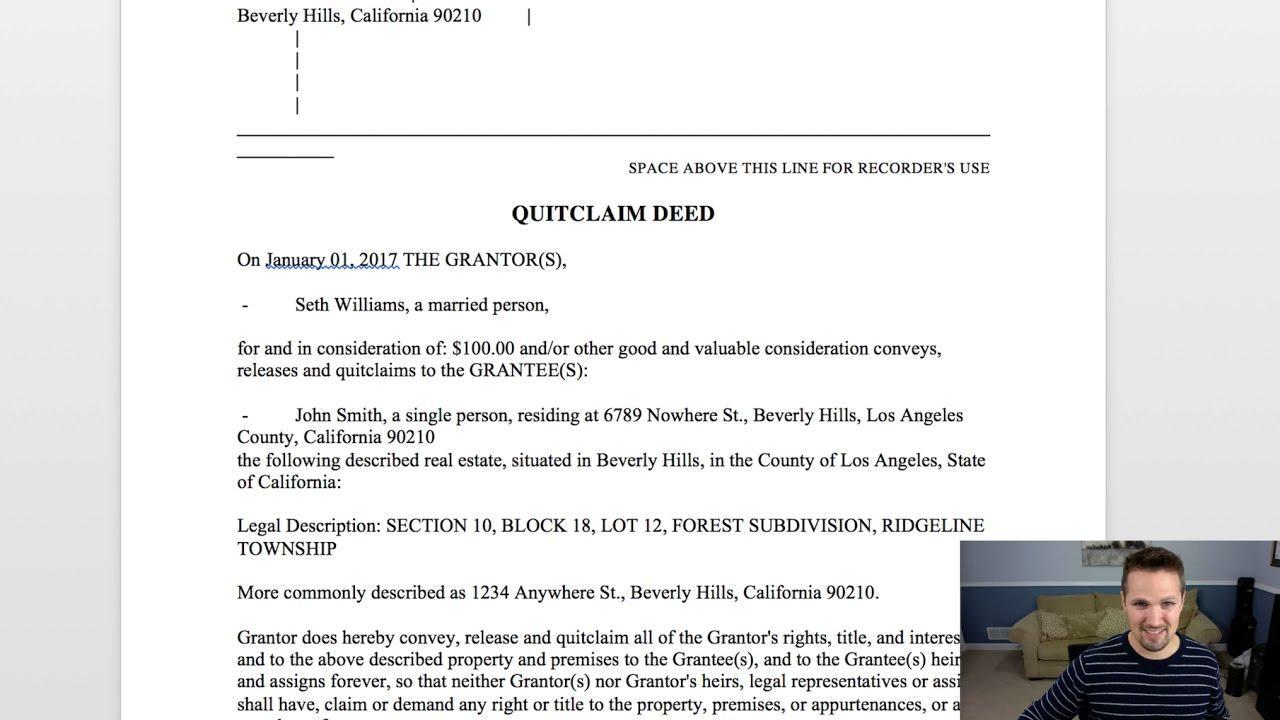For a swift and effective transfer of property ownership, the quit claim deed is an unparalleled legal document. Whether you’re aiming to add or remove a name from a property title or simply wish to establish ownership rights, it’s crucial to comprehend how to secure a quit claim deed. In this article, we’ll delve into the process of obtaining this vital legal document and the essential details you need to be aware of.
Grasping the Function of a Quit Claim Deed
In the realm of real estate dealings, a quit claim deed is a potent legal instrument that facilitates the transfer of property ownership from one party to another. It’s vital to grasp the function of a quit claim deed before entering into any agreement. Here are some crucial aspects to bear in mind:
- A quit claim deed is frequently used to transfer property among family members or during a divorce.
- Unlike a warranty deed, it doesn’t provide any assurances about the property’s title or condition.
- It’s imperative to fully understand the terms specified in the quit claim deed before signing it.
Securing a quit claim deed allows you to transfer property ownership swiftly and effortlessly, bypassing a protracted legal procedure. Here’s a straightforward guide on how to secure a quit claim deed:
| Step | Description |
|---|---|
| 1 | Complete the required details on the quit claim deed form. |
| 2 | Have the form notarized to render it legally enforceable. |
| 3 | Register the quit claim deed with the county recorder’s office. |
Essential Steps to Secure a Quit Claim Deed
When it comes to securing a quit claim deed, there are several key steps to remember to ensure a seamless and successful process. By adhering to these steps, you can effortlessly transfer property ownership without the inconvenience of a protracted legal procedure.
Firstly, it’s crucial to identify the property in question and collect all pertinent information such as the legal description and current ownership details. This information will be indispensable when completing the quit claim deed form.
Next, you’ll need to compose the quit claim deed document. This document should clearly specify the names of the parties involved, the property being transferred, and any relevant terms or conditions of the transfer. It’s important to verify that the document is accurate and complies with state laws.
Once the document is composed, all parties involved must sign the quit claim deed in the presence of a notary public. The notary will then authenticate the signatures, rendering the deed legally enforceable. Finally, the signed and notarized deed must be filed with the appropriate county recorder’s office to officially transfer property ownership.
Common Blunders to Evade when Securing a Quit Claim Deed
When securing a quit claim deed, it’s crucial to be cognizant of common blunders that can easily be evaded. By being aware of these potential pitfalls, you can ensure a seamless and successful transaction.
A common blunder to avoid is neglecting to conduct a comprehensive title search before securing a quit claim deed. Without a title search, you risk inheriting any existing liens or claims on the property. This can lead to legal complications and financial liabilities in the future. Be sure to conduct your due diligence and verify that the title is clear before proceeding.
Another blunder to avoid is not consulting with a real estate attorney. While quit claim deeds are typically straightforward, it’s always prudent to seek professional counsel to ensure you fully comprehend the legal implications of the document. An attorney can provide guidance and help evade any potential issues that may arise.
Lastly, be wary of rushing through the process. Take the time to scrutinize the quit claim deed carefully and ensure all parties involved fully comprehend the terms and implications. By adopting a methodical approach, you can evade costly blunders and ensure a successful property transfer.
Advantages of Engaging a Lawyer for a Quit Claim Deed
When acquiring or transferring property, it’s essential to understand the process. While it’s possible to secure a quit claim deed without legal assistance, there are several benefits to engaging a competent attorney.
One of the primary advantages of working with a lawyer for a quit claim deed is the assurance that the deed is properly composed and executed. An attorney can ensure that all necessary information is included in the deed, safeguarding both the grantor and the grantee from any potential legal issues in the future.
Additionally, a lawyer can provide invaluable legal counsel throughout the process, assisting in navigating any complexities that may arise. They can also assist with any title issues that may need to be addressed before the deed can be transferred.
Conclusion
In conclusion, securing a quit claim deed can be a straightforward process with the right guidance and information. By following the steps outlined in this article, you can ensure that your property transfer is seamless and legally sound. Remember to consult with a real estate attorney or title company if you have any questions or concerns along the way. With a quit claim deed in hand, you can enjoy peace of mind knowing that your property ownership is properly documented and protected. Happy transferring!

Unlocking the Secrets to Obtaining a Quit Claim Deed
When it comes to transferring ownership of property, one of the most important documents you may encounter is a quit claim deed. This legal instrument is commonly used in real estate transactions to transfer ownership interest from one party to another. Whether you are buying or selling property, understanding how to obtain a quit claim deed can be crucial to a successful transaction.
What is a Quit Claim Deed?
A quit claim deed is a legal document used to transfer ownership interest in a property from one party to another. Unlike a warranty deed, which guarantees clear title to the property, a quit claim deed makes no such guarantees. Instead, it simply transfers whatever ownership interest the grantor has in the property to the grantee. This means that if there are any liens or other issues with the title, the grantee will not be protected.
How to Obtain a Quit Claim Deed
Obtaining a quit claim deed is a relatively straightforward process, but it is important to follow the proper steps to ensure that the transfer of ownership is legally binding. Here are the key steps to obtaining a quit claim deed:
- Identify the parties involved: The grantor is the person transferring the ownership interest, while the grantee is the person receiving it.
- Prepare the deed: You can draft a quit claim deed yourself or have an attorney help you with the legal language.
- Sign the deed: Both the grantor and grantee must sign the deed in the presence of a notary public.
- Record the deed: The signed and notarized deed must be recorded with the county recorder’s office where the property is located.
- Transfer ownership: Once the deed is recorded, the ownership interest in the property is officially transferred.
Benefits of Using a Quit Claim Deed
While quit claim deeds do not offer the same level of protection as warranty deeds, they can still be useful in certain situations. Some of the benefits of using a quit claim deed include:
- Quick and easy transfer of ownership
- Can be used in family transfers or gifts
- Can be used to clear up title issues
Practical Tips for Obtaining a Quit Claim Deed
When obtaining a quit claim deed, there are a few practical tips to keep in mind to ensure a smooth transaction:
- Make sure the legal description of the property is accurate
- Verify the identity of the parties involved
- Consult with a real estate attorney if you have any questions
Case Study: John and Mary’s Property Transfer
John and Mary are siblings who inherited a property from their parents. They decide that Mary will buy out John’s share of the property, so they use a quit claim deed to transfer ownership. They follow the proper steps, including preparing the deed, signing it in front of a notary, and recording it with the county recorder’s office. The transfer is successful, and Mary now owns the property outright.
Firsthand Experience: Sarah’s Property Sale
Sarah is selling her house to a friend and decides to use a quit claim deed for the transaction. She consults with a real estate attorney to help her draft the deed and ensure that all the necessary steps are followed. The transfer of ownership goes smoothly, and Sarah is able to sell her house quickly and easily.
| Key Takeaways |
|---|
| Quit claim deeds are used to transfer ownership interest in a property |
| They do not offer the same level of protection as warranty deeds |
| Properly preparing, signing, and recording the deed is essential |



